No products in the cart.
Thick Bar

The 2″ solid steel axle weighs 73lbs empty.
A barbell or dumbbell having a handle 2″ in diameter or greater is considered a thick bar. These bars are typically smooth and are most often seen with 2″ or 2.5″ diameter handles. Training with a thick bar in the place of a normal bar places a large amount of stress on the supporting strength of the hands. This is the result of four factors:
- The large diameter of the bar reduces the lever advantage of the fingers
- The lack of knurling makes the bar harder to hold on to
- If the bar is thick enough, the fingers cannot touch and press into one another for support
- Most thick bars do not have weight sleeves that revolve
Avoid the temptation to perform all exercises in a workout with thick bars. While the grip will be trained extensively, work for the rest of the body will be lacking. Due to the non-revolving weight sleeves, certain ballistic movements (such as cleans), may be too hard on the wrists for regular thick bar training.
Thick Dumbbell Deadlift
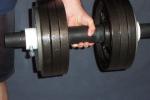
Lifting 70lbs on a 2.5″ dumbbell. Hand size is 7″.
Thick dumbbell deadlifts provide a basic, effective option for training the grip. Stand over a loaded dumbbell, squat down, and pick it up while keeping the back tight. Ensure the fingers and thumb are on opposite sides of the handle to properly train the supporting grip.
Individuals with strong wrists will find they can lift more weight by cupping their hand under the dumbbell and flexing the wrist while hard before pulling the weight. This is a great exercise for training wrist flexion but will do little to improve the supporting grip.
Thick Barbell Deadlift
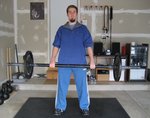
Warming up with a double overhand grip on the axle.
Deadlifts performed on a thick barbell are an excellent tool for training the supporting grip. Due to injury risk of an incorrectly performed deadlift, lifters should obtain expert instruction on deadlift form before pursuing thick bar deadlifts.
To perform this exercise, stand in front of a loaded thick barbell, with the feet a little wider than shoulder width apart. Squat down with the arms outside the legs and grasp the bar with a double overhand grip (palms facing the body). Focus on crushing the barbell with the hands and driving through the heels to stand with the weight. Do not let the back round.
Experienced strength athletes will find that back strength is rarely a limiting factor in this lift. As a result, several deviations from conventional deadlift form should be experimented with for improved performance. These include:
- Allow Bar Drift – Do not drag the bar up the thighs. While dragging maximizes leverage for the back, it also creates additional friction on the bar, increasing stress on the grip. Drag may be reduced by allowing the hips to rise slightly ahead of the thighs.
- Pull Slowly – Do not explode out of the bottom position of the lift. Speed on the bar is not needed to reach lockout. A sudden burst of force off the ground will strain the grip much harder than a smooth, steady pull.
- Sumo Deadlift – Consider performing the lift using sumo deadlift form, with the feet spread wide and the hands close together on the barbell, between the legs. This will shorten the length of the pull and is legal form in grip contests. Sufficient hip flexibility is needed to make this option work.
Individuals who do not regularly train the deadlift may find their back is a limiting factor in this lift, rather than the grip. Switching to sumo deadlift form, as described above, may be enough to allow the lift with full range of motion.
Performing the lift over a partial range of motion is another option that will offer similar benefit. Try raising the bar to just above knee height using the pins of a power rack or by pulling from blocks. Keep control when setting the barbell back down in a rack, to avoid bending rack pins or smashing fingers.
Double overhand deadlifts on a 2” barbell are often referred to as axle deadlifts. With proper training, pulling 1.5 times bodyweight on an axle is within the reach of most individuals. Anything in the range of double bodyweight is exceptional. Advanced grip trainees often pull over 300lbs on this lift, with world class lifters occasionally breaking the 400lb barrier.
Homemade Thick Bar
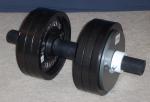
Metal pipe makes an excellent thick dumbbell.
A thick bar is one of the easiest pieces of equipment to make at home. For a simple solution, sleeve an existing barbell or dumbbell handle with a piece of 1.5″ diameter schedule 40 PVC pipe. This will yield a 1.9″ bar. To make it 2.4″, add a piece of 2″ PVC pipe on top of the 1.5″ PVC pipe. The cost to sleeve an Olympic barbell to 2.4″ should be less than $10. Most hardware stores will cut pipe to length for little or no charge.
Another option is to cut a piece of 1.5″ schedule 40 metal pipe to the desired bar length and add weights directly to it. Use schedule 80 pipe to handle monster weights. Create stops for the weights by welding washers or short pieces of 2″ diameter pipe in the appropriate locations. Hose clamps or screw type barbell collars can be fastened in place if welding is not an option. To make the pipe bar thicker, cut a piece of 2″ pipe to sleeve over it. Be sure to leave space to add weights on either end of the bar. The 2″ pipe will act as a stop for the weights but should be welded on center if possible.
Keep in mind that because the outer diameter of the pipe acting as the weight sleeve is 1.9″, spring style collars will not work to hold the weights on. Use screw type collars or a make collars out of some additional pieces of 2″ pipe. Expect to spend $25-$50 to make a 74″ long thick bar with pipe.
Timed Hold
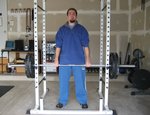
Hold deadlifts with ease.
The supporting grip often encounters endurance based challenges, such as holding onto a barbell during deadlifts or carrying heavy loads for distance. Timed holds are an effective option for training this endurance.
The timed hold consists of standing with a heavy barbell in a double overhand grip and holding it for 30-60 seconds. The movement usually starts with the barbell on supports in a power rack, a few inches below the locked out position. Weights near the lifter’s deadlift max are a good starting point. Great stress can be placed on the grip with lighter weights using a thick barbell.
The lifter with limited equipment can perform timed holds hanging from an overhead bar or tree branch. This will stress the supporting grip and can be progressively loaded by hanging weight from the feet. Little more than body weight is enough to challenge most, making this a good choice for those wishing to spare the lower back.
If a power rack and thick barbell are available, try placing the barbell on top of the rack and hanging for time or chinning for reps. This variation introduces an element of instability the greatly increases the challenge of the exercise.
One Hand Deadlift
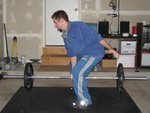
Keep the bar level.
The one hand deadlift is a classic test of supporting grip strength. The lift consists of lifting a loaded Olympic barbell from the ground to above knee height with one hand, while keeping the barbell level. Strong performers on this lift will raise well over half of their two handed deadlift max. Due to the offset loading placed on the body, it is common to place the free hand on the thigh to provide back support.
When performing this lift, it is important to align the center of the grip (usually below the middle finger) with the center of the barbell. Missing this position by even a half inch will turn the lift into a wrist exercises and significantly lower the weights that are used. A hook grip is not allowed.
Exercise difficulty is impacted by how freely the weight sleeves on the barbell spin. Heavier weights can be lifted on a bar with poor sleeve rotation. A slight bend in the bar will also allow for bigger lifts. Traditionally the lift is done on a bar with a knurled center, making the quality of knurl another complicating factor in comparing performances.
Rolling Handle
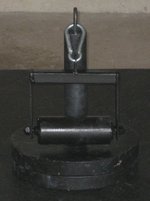
Metal rolling handles are durable and spin freely.
An economical option for training the supporting grip is a thick rolling handle. Typically 2.375 inches in diameter, the key to this device is an offset weight attachment affixed to the center of the handle on bearings. The bearings allow the handle to rotate as a weight is moved, making it difficult to assist the supporting grip by flexing the wrist. This feature aligns the force of pull on most exercises with the weakest point of the supporting grip, where the fingers tips meet the thumb.
Rolling Handle Deadlift

Smooth bearings limit assistance from the wrist.
The most common exercise done on a rolling handle is a one handed deadlift. Weight is added to a loading pin on the ground, which is then attached to the bottom of the handle. The lifter straddles the weight and lifts the handle with one hand. The thumb must be on the opposite side of the handle as the fingers, preventing the use of wrist flexion to cheat the lift. Few men will break the 200lbs from the ground in this fashion.
Ironmind popularized the lift with their Rolling Thunder handle, a 2.375 inch PVC sleeved implement. Rolling Thunder deadlift contests are held throughout the world, usually coinciding with strongman competitions. The world record is quickly approaching 300lbs, with a cash prize for first person reach the milestone.
Vertical Bar
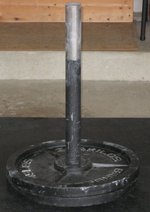
Use a 2″ vertical bar to train the grip pain free.
The vertical bar is a simple tool used to test and train vertical supporting grip. Tough hands and a high pain tolerance are needed to excel with this piece of equipment. The standard vertical bar is twenty four inches long and one inch in diameter. A flat plate is welded to the bottom of the bar, allowing weights to be loaded vertically.
Bar diameter may vary from 0.75 to 2.5 inches. Large bar diameters prevent an individual from wrapping the thumb over the fingers when lifting, quickly reducing maximum weights and risk of injury. Narrow bar diameters allow much heavier weights but tend to result in torn skin.
Vertical bars are often seasoned by coating the top of the bar in chalk. This can increase the amount of weight that will be lifted and has the effect of reducing the impact of humidity on the lift. As this lift is heavily dependent upon friction, the surface condition of the implement must be considered when comparing performance between individuals.
Vertical Bar Lift

Space large plates with small ones to ease weight management
The vertical bar lift trains the vertical supporting grip, as well as the toughness of skin on the palm and fingers. A twenty four inch long, one inch diameter bar is loaded vertically with plates, then lifted at least two inches off the ground with one hand. A hook grip is not permitted. As weights can exceed 400lbs, the lifter may brace the other hand on their thigh for support. Due to the extreme loads, care must be taken to build up slowly when training this lift. The following factors should be taken into account:
- Offset Loading – Weight exceeding the lifter’s body weight will be lifted with a single hand. This offset loads places considerable stress on the spine. Individuals with back problems should take caution when training this lift.
- Bar Rotation – Once lifted, the vertical bar will begin to rotate. A practiced vertical bar lifter can dampen this rotation, but it cannot be eliminated. Care must be taken to protect the shoulder and wrist.
- Skin Stress – The heavy load plus bar rotation places a large amount of stress on the soft tissues of the hand. When pushing limits on this lift, it is likely skin will tear on the outside of the pointer finger or the palm of the hand near the base the ring finger. Skin that is about to tear will burn and turn pink, providing an early warning sign to avoid injury. Training the lift with a regular frequency, increasing volume gradually over time, and doing five to ten sub-max singles to warm up will reduce the risk of lost skin.
- Hand Position – Performance on the vertical bar lift can be improved by optimizing hand position. Grasp the bar diagonally with the palm to maximize the amount of skin in contact with the bar. Wrap the thumb over the pointer and middle fingers to increase the amount of pressure that can be applied. Consider varying hand position on each attempt to distribute stress throughout the hand, avoiding hot spots and increasing the number of lifts that can be tolerated in a training session.
Larger diameter vertical bars can be used to decrease loads needed to train the vertical supporting grip and reduce stress on the supporting tissues. While the lift can be a powerful training tool, it should be approached with caution.
